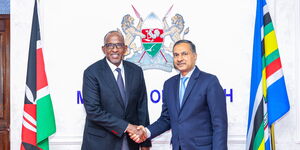President William Ruto on Wednesday, May 3, unveiled a new university funding model as a solution to the debt crisis bedevilling public universities.
In a press briefing from State House, Ruto explained that the new model will be student-centred and the funds will be channelled through scholarships and loans.
Ruto noted that the new model did not increase university fees adding that the government would increase the financial budget allocated to the institutions.
"This new funding model does not increase university fees. Under the new model, we are increasing the university allocation in the new financial year from Ksh54 billion to Ksh84.6 billion.
"Universities and TVETS will no longer receive block funding in the form of capitation based on a differentiated unit cost. Funding to students shall combine scholarships, loans and household contributions on a graduated scale," he stated.
He explained that students would be divided into three categories including the Vulnerable, the Less Vulnerable and the Able and will receive funding according to the categories.
The Head of State noted that the government would give full scholarships to the vulnerable students and therefore their parents would not pay any amount for the education of their children.
"Their parents will contribute nothing. The funding shall be through government scholarships and loans," Ruto stated.
However, for the students in the less vulnerable category, the government would offer them a scholarship that would pay up to 53 per cent of their education and issue them with a 40 per cent loan.
At the same time, those joining TVET institutions under the category will receive scholarships of 50 per cent of their fees and 30 per cent in loans.
"Their Households will only pay for 7 per cent of the cost of their University Education.
"Those joining TVETS will receive government scholarships up to a maximum of 50 per cent and 30 per cent In loans. Their Households will pay 20 per cent of the costs," Ruto explained.
On the other hand, the less needy students joining university will get scholarships of up to 38 per cent of the cost of their education and loans of 55 per cent.
"Their households will pay only 7 per cent. For those joining TVETS, they will be funded 32 per cent for government scholarships, 48 per cent for loans and their households will pay 20 per cent of the costs," he added.
Ruto warned public universities against imposing additional costs on the programmes offered at various institutions.
"No public university shall levy additional charges or raise its fees without the approval of the University Funding Board," added the Head of State.
Moreover, the president added that the new model will take effect in the next education year and all continuing government-sponsored students will be supported in line with the previous model.
according to the president, the new model was adopted after recommendations by the Presidential Working Party on Education Reform in Kenya led by Prof Raphael Munavu and several meetings with Vice chancellors or public universities in the country.












